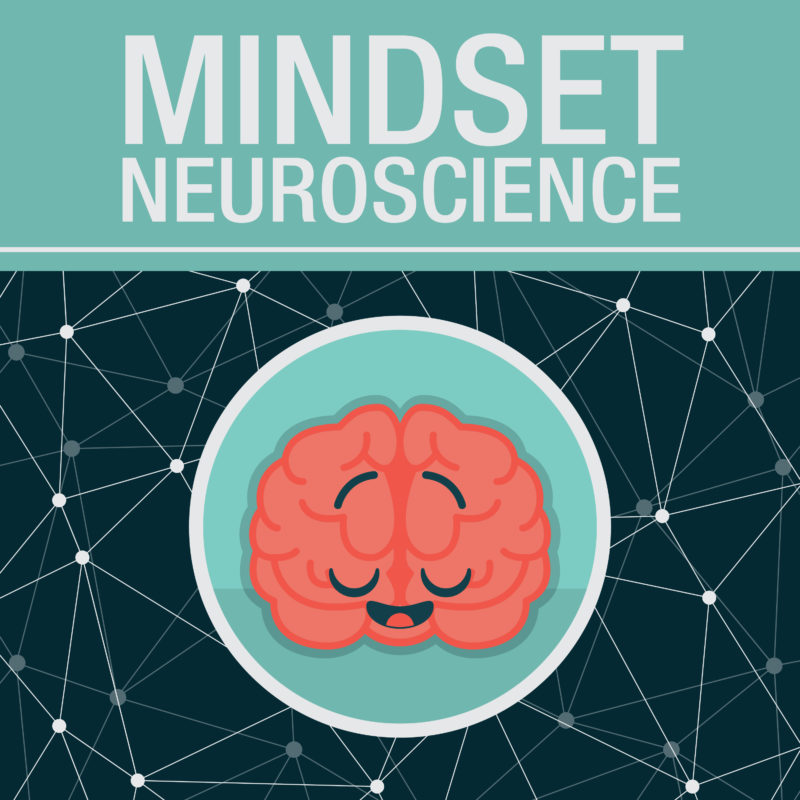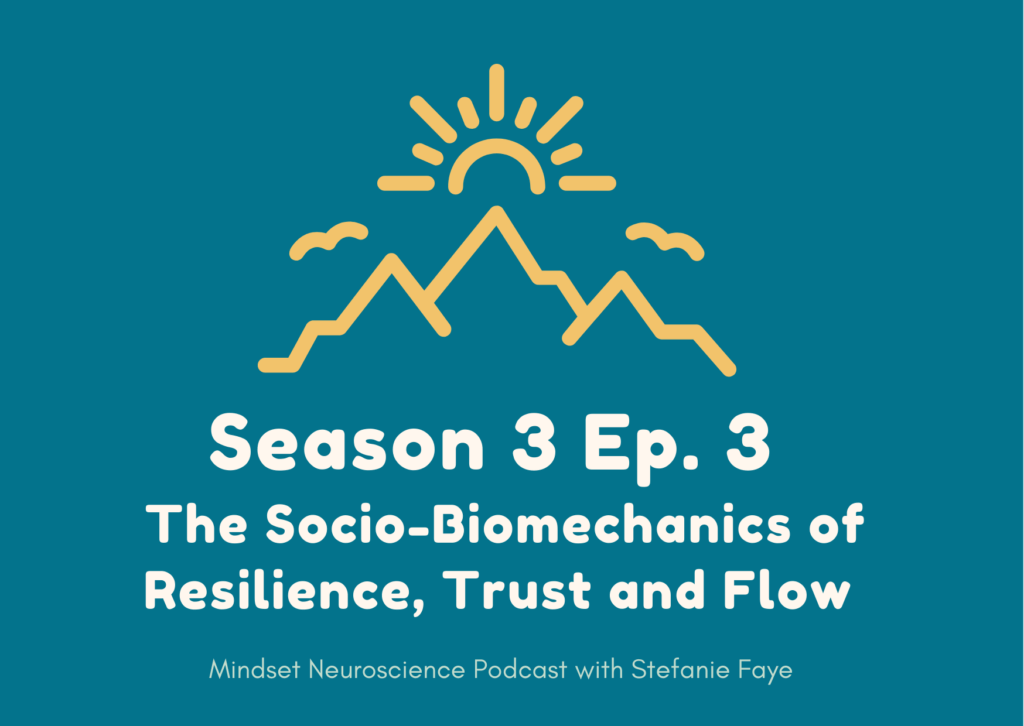
Studying human brains while a person is immobile and alone in an mri machine can only get us so far in truly understanding human brains and behaviors. Because optimal brain development requires serve-return exchanges with conspecifics (members of the same species), affiliative neuroscience moves us into an exciting new era of understanding.
Affiliative neuroscience is an emerging field that combines neurophysiology (including neuroendocrine and EEG hyper-scanning*) attachment theory, and highlights the evolution of social acts within mammals, nonhuman primates, and humans.
My interview with expert rock-climber Alma Esteban parallels affiliative neuroscience research and how we coordinate, move and attune to others as a way to solve problems and ascend to new heights. Before we go into that, let's take a look at Affiliative Neuroscience
Resilience-by-affiliation
Much of the current research on resilience focuses on fear physiology and stress neurobiology. Affiliative neuroscience seeks to understand this as well but also what cultivates strength and stamina. Within this, pioneer researcher Dr. Ruth Feldman defines resilience as the "hallmark of human achievement", which includes the ability to*:
- Face life’s hardships with courage and perseverance
- Enjoy intimacy and wider social circles
- Have empathy and compassion to others’ misfortune
- Foster a sense of industry and agency towards long-term goals
- Access creativity, vitality and meaning
- Be free of debilitating symptoms despite early adversity or current trauma
Affiliative neuroscience points to coordinated actions of sociality as a mechanism for increasing endurance, diversity and adaptation, thus optimizing us as a species.
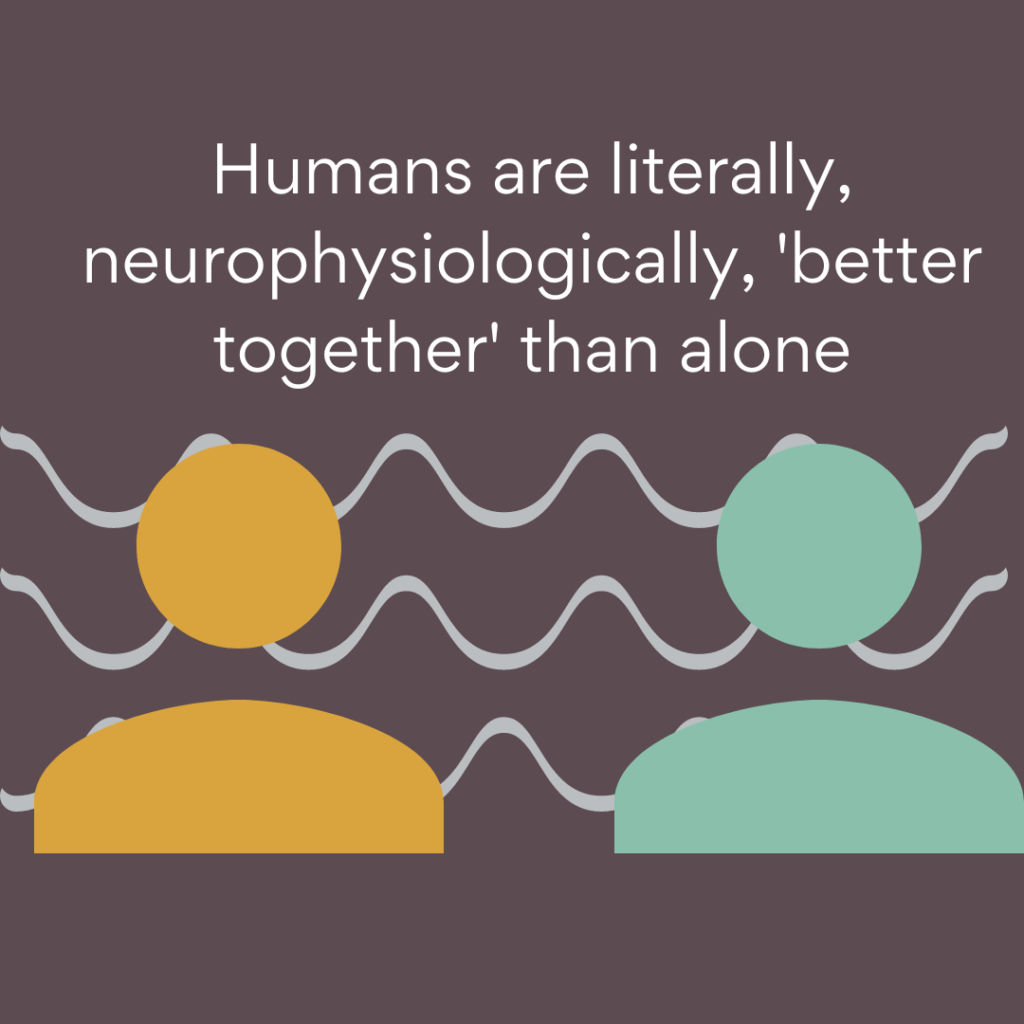
Humans are literally, neurophysiologically, 'better together' than alone
Social neuroscience research shows that we achieve goals more efficiently and accurately when we coordinate our motor behavior with someone we have a long-term bond with, particularly couples. One of the reasons for this comes from having high levels of exposure to the others’ patterns of movement, which helps each brain create better predictions and automations for reading and responding to signals. Trusting, attuned, joint-problem-solving partnerships optimize our individual and collective functioning. Unfortunately, as children, many of us did not have parents with this type of partnership for us to use as guides for our own future relationships. We need more models of this for future generations.
Affiliative neuroscience shows us that bonding and affiliation are embedded in our DNA. Ignoring this fact will result in continued mental health challenges and depletion of well being and functioning. We are wired to seek out connection. This means that if a person is not getting it in their physically proximal environment, there is a good chance that they will seek it out in other ways. For many people today, this will happen online.
For some of us who are able to regulate ourselves and have enough other types of connections, online bonding is an amazing way to connect with people who we may never get a chance to in our daily lives. But for people who do not have consistent in-person bonding moments with people they trust, online connections can lead to depletion of wellbeing as well as a false sense of belonging and acceptance based on inaccurate mental models that get created in the brain.
The brain-body system requires multi-sensory-based frequencies to accurately assess another’s intentions and internal state. If it does not get this, it will ‘make do’ with what it gets, and create representations based on incompleteness. I think this is dangerous for mental health and for us as a society and a species.
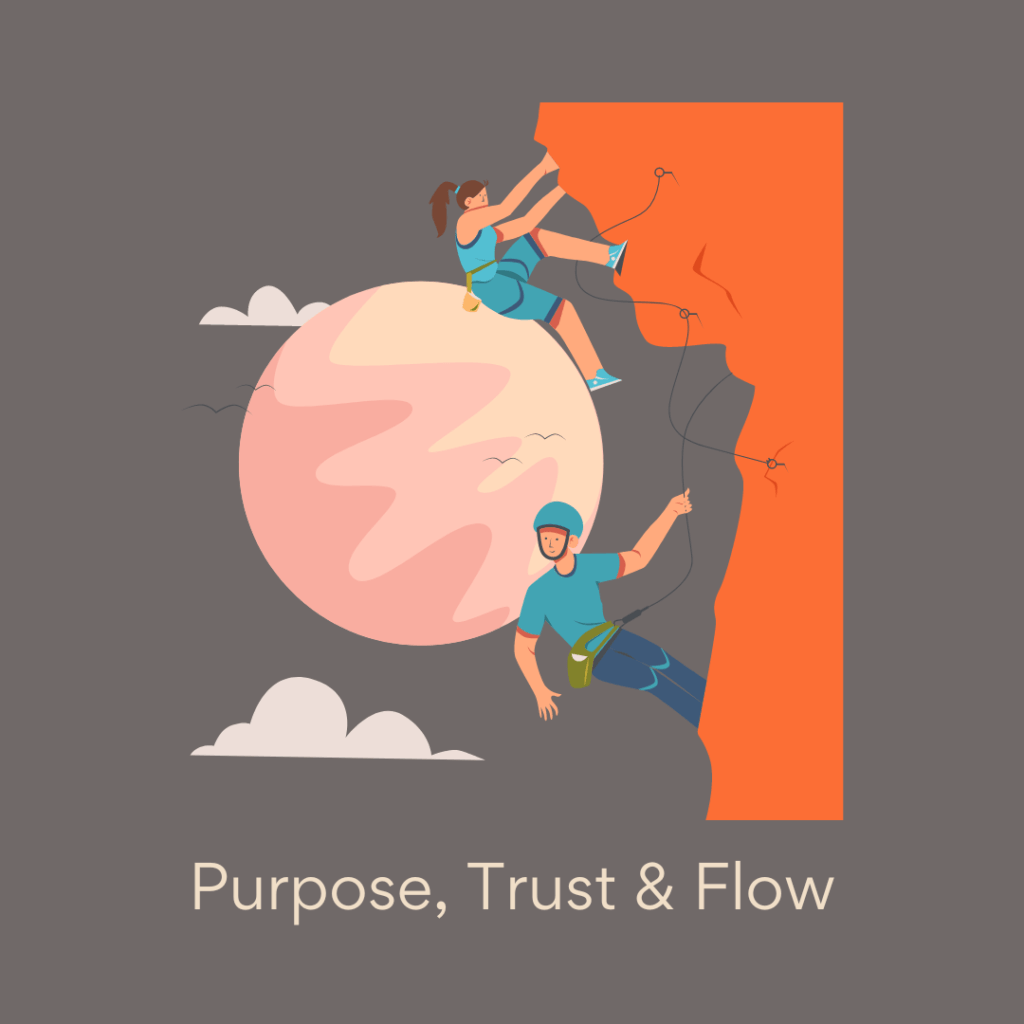
Purpose, Trust and Flow
Self-Attunement
During moments of challenge during rock-climbing, Alma describes a strategy of tuning in very closely to her breath. She becomes very present to her own body and what is occurring.
While we need people to help us regulate, the actual work of regulating our internal systems does come down to what we personally end up doing with our beam of awareness, body and breath. No one can breathe for us, they can’t shine the spotlight in our mind somewhere differently. We must do this within ourselves. Another person can be there as support, but the actual work of becoming present and clear-minded always comes back to us. So there is a dance between staying open to support from others, and also knowing that we can turn inward to our breath and an internal sense of calm so that we can get through challenges.
Other-Attunement
In climbing, you rely on your partner and your partner relies on you. Alma cannot make decisions that will put her partner in harm’s way. Alma must tune in to her partner’s signals of distress: sometimes these are verbal, sometimes not; sometimes they are microsignals of tension in the rope, or the sound of their breathing.
This is a beautiful parallel to our human social lives. One of the pillars of secure attachment is that secure partners keep the other partner’s wellbeing in mind as they make decisions. They are able to hold their perspective and tune in to their own needs, while tuning in to their partner’s signals of distress or desire. This is in contrast to insecure partners or caregivers, who only hold their perspective and only consider their distress and needs, while ignoring or being unable to tune into or understand their partner’s or children’s.

An ideal climbing partner acknowledges that some partners are very verbal and obvious in their support, but others are there in a subtler, nonverbal or action-oriented way. One way is not better than the other - but it takes awareness and trust to know that whatever form of support they are giving is aligned with what they are able to give. For example, Alma doesn’t expect high levels of enthusiasm from someone who doesn’t operate that way - she looks for how they support her in their own unique way.
This level of being able to tune in to each other’s signals requires time and a track record. The more they climb together, the better and more proficient they get at attuning and responding. But they need to make it through the first series of climbs where they don’t necessarily know each other’s signals well. This requires a high level of presence, self-regulation and trust in the process. This is exactly what studies using two-person EEG reveal: having long histories of coordinated problem-solving and action patterns with another is what leads to complementary brain and motor activity and more precision in achieving goals.
A Common Purpose
Both partners want the other to succeed. Success comes from solving a problem they’ve never solved before. From pushing through fear of uncertainty. From working through a challenging situation and not giving up. From creating a level of support that the other can trust so deeply that they are willing to reach for that rock, that crevice, that level they think they might not be able to reach. They can only reach for it if they can trust that the line and partner are there to support them if they fall.
There is no jealousy or trying to ‘one-up’ the other. This would risk both of their safety. They both want to ascend to a new peak they’ve never reached before. They both want to use their skills, perseverance, and desire to get to the next vantage point.
However, they don’t put the goal of reaching the peak ahead of their purpose. The goal may be a certain peak. But the purpose of all of it is to attain mastery of themselves, and mastery of navigating problem-solving - internally and with another. If the goal was only to climb higher, they would potentially ignore signs that they needed to rest or back off. With a purpose of sharing the experience of growth, mastery and trust, they can allow for shared failures, falls and mistakes. They won’t put each other in harm’s way - they want the other to be as high-functioning as possible. To do this, they must stay highly attuned to each other’s signals - and rest if the other needs rest, encourage and hold the line when the other wants to give up, cheer on when the other is pushing through to a new position.
This aligns powerfully with what we see in affiliative neuroscience and the importance of empathic attunement. In hyper-scanning of people with long-term bonds, there is a widely-distributed activation of complementary brain activity and reported feelings of being supported.
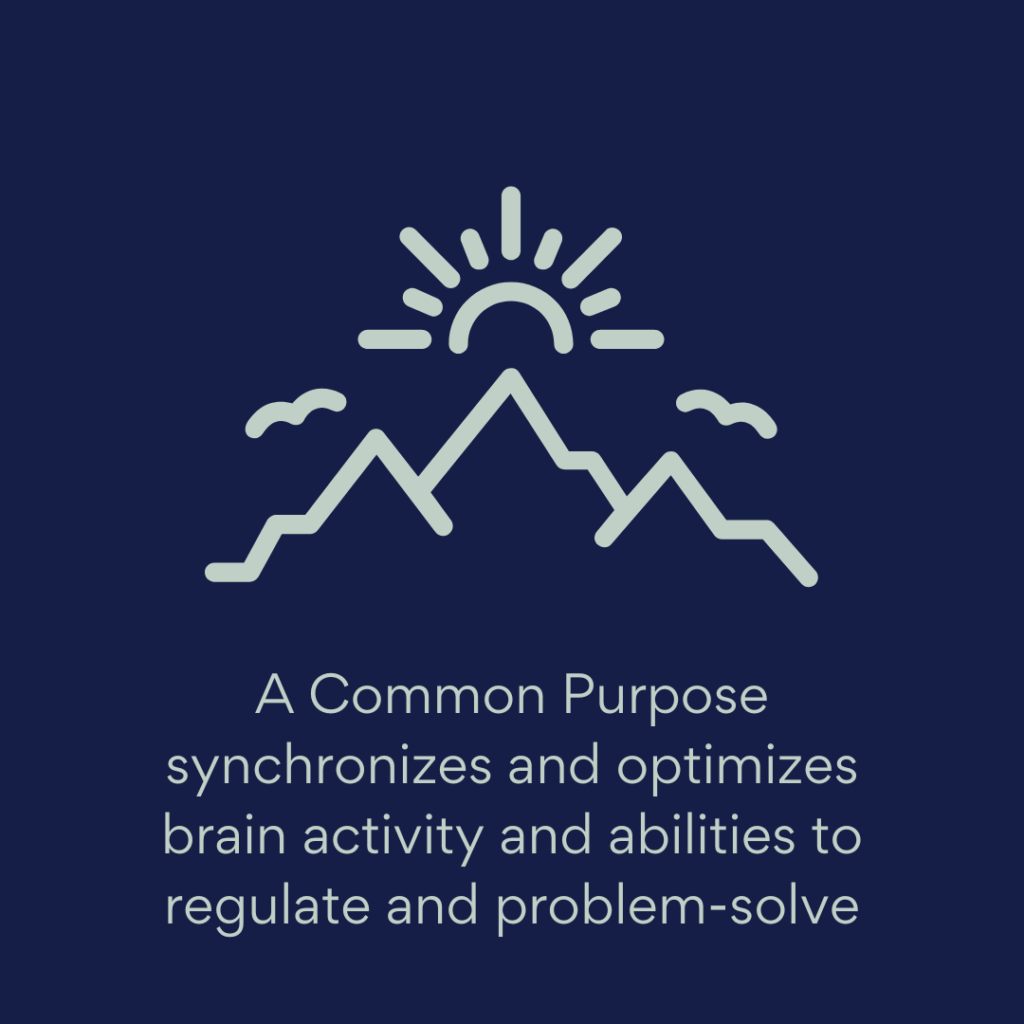
A last theme that emerged from this episode with Alma was trust and flow
Trust in Natural Intelligence and Flow
To be able to push oneself to a new level and reach new heights, a rock-climber must trust in their own abilities. This comes from repeatedly failing, falling and fumbling but then finding ways to get back up and move on. As we do this, we create new neural associations with the initial dysregulation that may happen as something goes wrong or unexpected.
Each time we survive and find a new path forward after a mistake or failure, our brain-body system can begin to stop associating failure with ‘death’ and re-associate it with growth.
To evolve new circuits, we must have new problems to solve. Otherwise, the brain is able to coast along on what it already has as its algorithms. By trusting in our brain’s capacity to learn and solve new problems, we can become more willing to try new things.
This requires trust in a level of intelligence that is beyond our ability to understand. The amount of information our senses take in at every moment and that are stored out of reach from our conscious access is unfathomable.
We cannot comprehend in any type of conscious way what our body and cells know how to do. And yet they figure out trillions of problems each day. When you cut your finger, do you consciously know how to get the cells to work together to get the skin to scab over and then heal? Your cells know things you can’t possibly figure out. (Notice also that the cells must attune to each other's signals and solve a joint problem.)
Moreover, your body has been exposed to the laws of physics for your entire existence. The reliability of the physical laws of the universe is something our bodies and cells understand in ways our conscious mind cannot. When we begin to trust that there is a level of intelligence within us that we may not fully understand, this can allow us to solve problems in new ways. This is tied to what we know of as ‘flow’, which Alma talks about accessing in times of extreme challenge during climbing.
The empathically attuned and joint-problem-solving aspects of mammalian and human adaptation and endurance are the key ingredients to understanding mental health and resilience. Affiliative neuroscience will help us get better at predicting and preventing mental health challenges as well as help us ascend to higher levels of optimization.
For more information about Alma and her work with Mountains Beyond Borders, go to:
https://mountainsbeyondborders.org/

